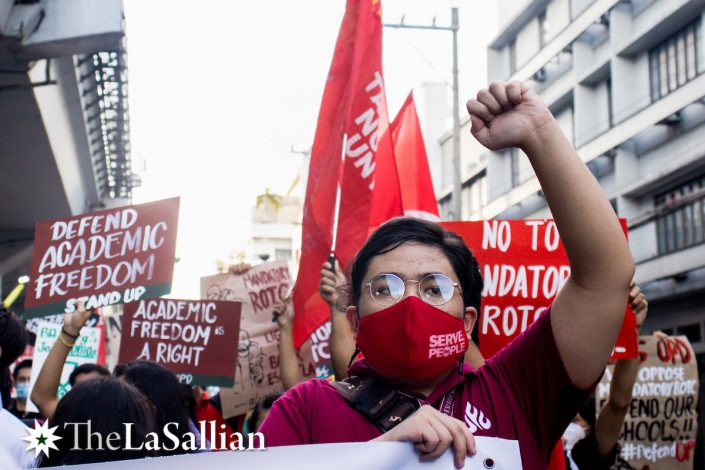A flock of green marched across the University’s halls last November 17 in a mobilization commemorating International Students’ Day. The group later joined students from various universities across Metro Manila in España Blvd., forming a bigger crowd to air their opposition toward the proposal to once again make the Reserve Officers’ Training Corps (ROTC) program mandatory, and dismay against the government’s failure to uphold the safe reopening of classes, among other issues faced by the education sector.

Their unity walk—originally planned to culminate at the Mendiola Peace Arch—was stopped along Recto Ave. by a human barricade of Manila Police District officers in riot gear and a fire truck ready to disperse the group for not having the proper permits. The program was disrupted and the organizers were forced to make a last-minute move to Liwasang Bonifacio.
Questionable university systems
The chant “Defend [academic] freedom”—a collective response from frustrated attendees whose universities were purportedly apathetic to their student body—echoed throughout the University Belt. More than a thousand students called for their universities’ administration to improve on systems they believe have been lacking since the start of the academic year (AY).
One of these is fourth-year Philippine Christian University undergraduate Erika Cuevas, who criticized her university’s patchy hybrid learning implementation: the decision on whether their classes are online or face-to-face is entirely dependent on their instructors, providing no uniform structure for a single schedule.
Hybrid learning at the Polytechnic University of the Philippines was also met with criticism. Third-year student Mhing Gomez revealed that his university’s definition of “hybrid” actually means no more than six face-to-face sessions for a single semester.
“‘Yung [ganoong] tipo ng model ng pagkatuto, imbis na [gawing matalino] ‘yung mga estudyante ay patuloy lang pinupurol ‘yung talino ng mga kabataan,” he commented.
(That type of learning model dulls the minds of the youth.)
Meanwhile, improved communication between the administration and students is something University of Santo Tomas second-year student Lorenzo Galvez wished for his university. His college’s slow and inefficient dissemination of information had become such a large issue that his batch resorted to depending entirely on gossip and word of mouth.
Galvez protested, “Ang bagal ng dissemination of information to the point that the news that we hear comes from hearsay. All we ask…is a speedy way of delivering information.”
Observations on the hybrid learning system in DLSU are less critical based on what Gomez, Cuevas, and Galvez described, yet Alyansang Tapat sa Lasallista’s vice president for external affairs candidate Arvin Ajesta noted in his speech, “[Mayroon pa ring] kakulangan in terms of the implementation [ng] ating learning modalities.”
(We are still lacking a few things in terms of the implementation of our learning modalities.)
Ajesta, who was about to address the crowds for the program proper but stopped as rallyists had to run to Liwasang Bonifacio, mentioned the lack of readings, presentations, and other learning resources in hybrid and pure online courses. He also criticized the University’s COVID-19 protocols when campuses reopened their doors in AY 2022-2023. More stringent implementation of health protocols is what he hopes the University will aim for, while pressing the administration to create a student-centric curriculum.
Mandated service
Dissent against mandatory ROTC was a major talking point during the protest. Other than echoing the concerns of students, Kabataan Party-list Representative Raoul Manuel highlighted that the budget for the proposed revival of the mandatory ROTC program could be better spent to address more persistent problems.
Manuel asserted that the budget needed to revive the mandatory ROTC program, which Senator Win Gatchalian had estimated to be P38 billion a year, could be better spent in building more classrooms and providing student aid.
Furthermore—should mandatory ROTC happen and state forces enter educational institutions—he fears that red-tagging and silencing student voices would be more rampant.
“Instead na mauna pang pumasok ang ating mga estudyante sa campus baka mauna pa ang militar at kapulisan. Of course, ang ROTC, magiging daluyan ‘yan ng indoctrination galing sa ating state forces,” Manuel stressed. “We know na kapag sila’y nagco-conduct ng lecture, ang laman niyan ay red-tagging, pagpigil sa youth participation sa national affairs.”
(The military and police force might be the first to enter campuses instead of the students. We know that when they conduct lectures, they will red-tag and stop youth participation in national affairs.)
